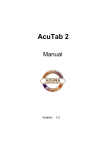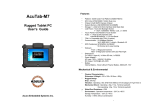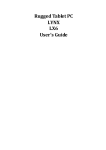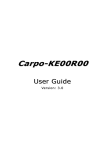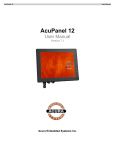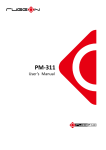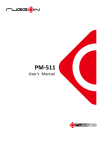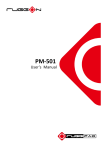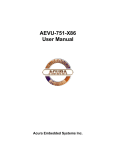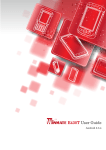Download Acura Embedded AcuTab-M User guide
Transcript
AcuTab-A Based on Android 2.3 User Guide Version: 1.5 Updated by March 29/2013 Acura Embedded Systems Inc. Technical Support Acura Embedded Systems Inc. Unite #1,7711-128th Street, Surrey,BC V3W 4E6, Canada Tel : 1-866-502-9666 Fax: 604-502-9668 Technical Emailt: [email protected] Introduction 1. Please read these safety instructions carefully. 2. Please keep this User’s Manual for later reference. 3. Please disconnect this equipment from connecter before cleaning. Don’t use liquid or prayed detergent for cleaning. User moisture sheet or cloth for cleaning. 4. Make sure the equipments are connected to the power source with the correct voltage, frequency, and ampere. 5. All cautions and warnings on the equipment should be noted. 6. Never pour any liquid into opening: this could cause fire or electrical shock. 7. Never open the equipment. For safety reason, the equipment should only be opened by qualified service personnel. 8. If one of the following situations arises, get the equipment checked by a service personnel: a. Liquid has penetrated into the equipment. b. The equipment has been exposed to moisture. c. The equipment has not worked well or you cannot get it work according to user manual. d. The equipment has dropped and damaged. If the equipment has obvious sign of breakage. 2 9. Caution on use of battery: User the battery recommended by the manufacturer or the same type of battery installed by the manufacturer. If incorrect battery is used, it may cause explosion or fire hazard. Recycle or discard used batteries according the manufacturer’s instruction or your local authority. 10. The computers use nonvolatile memory that requires a battery to retain system information when power is removed. The 3V lithium battery is on the system board. The battery life depends on the amount of time the computer is powered on. If the computer does not display the correct time and date, replace the battery. IMPORTANT:Loss of BIOS settings occurs when the battery is removed. BIOS settings must be reconfigured whenever the battery is replaced. WARNING:A risk of fire and chemical burn exists if the battery is not handled properly. Do not disassemble, crush, puncture, or short external contacts, or expose the battery to temperatures higher than 60 °C (140 °F). Do not dispose of a used battery in water or fire. CAUTION:Danger of explosion if battery is incorrectly replaced. 3 Replace only with same or equivalent type recommended by the manufacturer. Discard used batteries according to the manufacturer’s instructions. FCC Compliance Statement This equipment has been tested and found to comply with the limits for a class B digital device, pursuant to part 15 of the FCC Rules. These limits are designed to provide reasonable protection against harmful interference in a residential installation. This equipment generates uses and can radiate radio frequency energy and, if not installed and used in accordance with the instructions, may cause harmful interference to radio communications. However, there is no guarantee that interference will not occur in a particular installation. If this equipment does cause harmful interference to radio or television reception, which can be determined by turning the equipment off and on, the user is encouraged to try to correct the interference by one or more of the following measures: -- Reorient or relocate the receiving antenna. -- Increase the separation between the equipment and receiver. -- Connect the equipment into an outlet on a circuit different from that to which the receiver is connected. -- Consult the dealer or an experienced radio/TV technician for help. 4 FCC Caution: Any changes or modifications not expressly approved by the party responsible for compliance could void the user's authority to operate this equipment. FCC RF Radiation Exposure Statement: 1. This Transmitter has been demonstrated co-location compliance requirements with Wi-Fi, Bluetooth SiP (System in Package) and RFID modules. This transmitter must not be co-located or operating in conjunction with any other antenna or transmitter. 2. This equipment complies with FCC RF radiation exposure limits set forth for an uncontrolled environment. This device was tested for typical hand held operations with the device contacted directly to the human body to the back side of the tablet pc. To maintain compliance with FCC RF exposure compliance requirements, avoid direct contact to the transmitting antenna during transmitting. Europe ‘ EU Declaration of Conformity This device complies with the essential requirements of the R&TTE Directive 1999/5/EC and EMC directive 2004/108/EC. The following test methods have been applied in order to prove presumption of conformity with the essential requirements of the R&TTE Directive 1999/5/EC and EMC directive 2004/108/EC: 5 EN 55022: 2010 EN 61000-3-2 : 2006 +A2:2009 EN 61000-3-3 : 2008 EN 55024: 2010 (IEC 61000-4-2: 2008; IEC 61000-4-3: 2010; IEC 61000-4-4: 2011; IEC 61000-4-5: 2005; IEC 61000-4-6: 2008; IEC 61000-4-8: 2009; IEC 61000-4-11: 2004) EN 60950-1: 2001 Safety of information technology equipment EN 300 328 V1.7.1: 2006 EN 300 330 V1.7.1 EN 301 489-1 V1.8.1: 2008 EN 301 489-17 V2.1.1: 2009 EN 62311: 2008 This device is a 2.4GHz wideband transmission system (transceiver), intended for use in all EU member states and EFTA countries under the following conditions and/or with the following restrictions: In Italy the end-user should apply for a license at the national 6 spectrum authorities in order to obtain authorization to use the device for setting up outdoor radio links and/or for supplying public access to telecommunications and/or network services. This device may not be used for setting up outdoor radio links in France and in some areas the RF output power may be limited to 10 mW EIRP in the frequency range of 2454 ~ 2483.5 MHz. For detailed information the end-user should contact the national spectrum authority in France. 7 Table of Contents Introduction .............................................................. 2 Chapter 1 General Information............................ 11 1.1. Introduction .................................................................................... 11 1.2. Specification................................................................................... 11 1.2.1. Main System........................................................................................ 11 1.2.2. I/O Interface......................................................................................... 13 1.2.3. In Front Control.................................................................................... 14 1.2.4. Power Management............................................................................. 14 1.2.5. Environment ........................................................................................ 14 1.2.6. Material ............................................................................................... 15 1.2.7. Operation OS....................................................................................... 16 1.2.8. Certifications........................................................................................ 16 1.2.9. Optional: Internal Module ..................................................................... 16 1.2.10. Optional: External Accessories ........................................................... 17 1.2.11. Optional: Packing Lists ....................................................................... 19 8 1.3. Packing List.................................................................................... 20 1.4. Dimensions..................................................................................... 20 Chapter 2 System Setup....................................... 23 2.1. Exploring Your AcuTab-A..................................................... 23 2.1.1. The front side of the AcuTab-A.............................................. 23 2.1.2. The rear side of the AcuTab-A.............................................................. 28 2.1.3. The right side of the AcuTab-A ............................................................. 29 2.1.4. The left side of the AcuTab-A................................................................ 30 2.1.5. The bottom side of the AcuTab-A.......................................................... 33 2.2. Preparing for Installation................................................................ 33 2.2.1. Installing the Rubber Bumpers........................................................ 34 2.2.2. Removing the Rubber Bumpers...................................................... 34 2.2.3. Plugging to the DC supply .............................................................. 34 2.2.4. Starting Your System...................................................................... 36 2.2.5. Connecting the keyboard and mouse.............................................. 37 2.3. Using Your Android Operating System .........................................38 2.3.1. Application Control ......................................................................... 38 2.3.2. Screen Hotkey Utility for function controls ....................................... 39 9 2.3.3. Menu Controls................................................................................ 39 Chapter 3 Using the AcuTab-A ................. 43 3.1. Introduction .................................................................................... 43 3.2. Using the USB Ports.......................................................................43 3.3. Using the External Audio System.................................................. 44 3.4. Installing the Battery ......................................................................45 3.5. Using a SIM Card................................................................................ 46 3.5.1. Inserting a SIM Card ............................................................................ 46 3.5.2. Removing a SIM Card.......................................................................... 48 3.6. Using aBarcode Scanner Module (optional).........................................48 3.7. Using a MSR Module (optional)............................................................ 50 3.8. Using aTracker Module (optional)......................................................... 53 3.9. Using the Docking Stand (optional)................................................. 53 3.9.1. The right side of the Docking Stand................................................. 54 3.9.2. The rear side of the Docking Stand ................................................. 55 Chapter 4 Maintenance......................................... 57 4.1. Maintaining the Battery ..................................................................57 4.2. Maintaining the LCD Display.......................................................... 58 4.3. Cleaning the AcuTab-A......................................................... 58 10 Chapter 1 General Information 1 1.. Introduction AcuTab-A semi-rugged tablet PC is TI Cortex-A8 DM3730 1.0GHz processor core architecture based Semi-rugged Tablet PC with a bright 10.1-inch LED backlight LCD display. The powerful CPU brings the most dynamic applications to life without sacrifices to any industrial reliability. Delivery a variety of connectivity features, built-in USBs, Microphone and Headphone port. It is ideal for an all-around system performance. Furthermore, AcuTab-A semi-rugged tablet PC is equipped with fanless design. 1 2.. Specification The AcuTab-A semi-rugged tablet PC is a flexible, multi-functional flat tablet PC. With following specifications that can be applied in diverse operational environments and implemented in multi-faceted applications. 1.2.1. Main System Platform: -A8 Platform 11 MPU : -A8 DM3730 1.0GHz -FCBGA -die L2 Cache : 256KB Graphics : MPEG 4, JPEG and G711 supported System Memory : Flash Memory : Storage : LCD Screen : -inch LED Backlight LCD Touch Panel : -wire Resistive Touch Panel Sunlight Readable : Audio : front Bezel 12 Communication : 1 x Wireless IEEE 802.11 b/g/n 1 x Bluetooth 2.1 + EDR RFID (NFC) : 7KHz ISO/IEC 14443A/B, 15693 Mifare 1K/4K, Ultralight NFC-IP1 Protocol Webcam : -pixel Camera audio input (Microphone) functions. -pixel Camera, LED auxiliary light. 1.2.2. I/O Interface External I/O : 2 x USB 2.0 type A 1 x Headphone Jack 1 x Microphone Jack 1 x Docking Connector 1 x DC-Jack LED Status Indicator: 13 -Fi LED Status: 1 x Blue Color 1.2.3. In Front Control Switch : 1 x Power Button 1 x Lock Button 1 x RF Button Button : enter button ram Function Buttons : 5 x Function keys (Programmable) Sensor : 1.2.4. Power Management Power Adapter : , 50~60Hz input -in Battery (Internal Battery) : 1.2.5. Environment Operation Temperature : °Cto +45°C (MIL-STD-810G Method 501.5 and 502.5) Storage Temperature : 14 -20°C to +60°C (MIL-STD-810G Method 501.5 and 502.5) Humidity : -95% without condensation (MIL-STD-810G Method 507.5) Drop : -ft drop to Plywood (MIL-STD-810G Method 516.6 Procedure IV) Vibration : -STD-810G Method 514.6 Category 4 Fig 514.6C-3) Mechanical Shock : -operating : 40g, 11ms, Terminal sawtooth (MIL-STD810G Method 516.6 Procedure I) Water/Dust Resistance : IP55 equivalent 1.2.6. Material Chassis : -Rugged Tablet PC Slate Enclosure : Protective Rubber Grips Set Dimension (W x H x D mm) : 6 x 26.5mm Weight : 15 1.2.7. Operation OS Android 2.3 1.2.8. Certifications EMI : -3 / V-4) Safety : -1), CE RF : -1 / -17) (EN300 440 / EN301 489 / -1 -3) SAR : 1.2.9. Optional: Internal Module 3.5G : Protocol : GSM/WCDMA/HSDPA Frequency : GSM850/900/1800/1900MHz WCDMA/HSDPA 900/2100MHz Gobi3000 : 16 Protocol : HSUPA/HSDPA/UMTS/EVDO/EDGE Frequency : UMTS/HSUPA/HSDPA 850/900/1800/2100MHz CDMA/EVDO 800/1900MHz GSM/GPRS/EDGS 850/900/1800/1900MHz 1.2.10. Optional: External Accessories MSR : Reference Standards : ANSI/ISO Standards 7810,7811-1/6, 7813 JIS II Decoding Method : ISO Track1 - IATA , Track2 - ABA and Track3 - THRIFT Barcode Scanner : Decoded Mode : 1D Symbologies : EAN/UPC, RSS, Code 39, Code 128, UCC/EAN 128, ISBN, ISBT, Interleaved, Matrix, Industrial and Standard 2 of 5, Codabar, Code 93/93i, Code 11, MSI, Plessey, Telepen, postal codes. 2D Symbologies: Data Matrix, PDF417, Micro PDF 417, Maxicode, QR, Aztec, EAN.UCC composite. GPS : Channel : 50 channel all-in-view tracking 1 x Double Color LED (Red & Blue) OS : 17 Android 2.3 support GPS/GPRS Tracker : GPRS Frequency : Quad-Band: 850/900/1800/1900Mhz Compliant to GSM phase 2/2+ Class 4 (2W @ 850/900MHz) Class 1 (1W @ 1800/1900MHz) 1 x Double Color LED (Red & Blue) GPS Channel : 50 channel all-in-view tracking 1 x Double Color LED (Red & Green) OS : Win CE 6.0 support Desktop Docking : Win CE 6.0 : 4 x USB2.0 type A, 1 x Ethernet, 1 x Kensington and 1 x DC Jack support Android 2.3 : 4 x USB2.0 type A, 1 x Ethernet, 1 x Kensington and 1 x DC Jack support External Battery Kits : External Battery Pack : Hot-swappable Lithium Polymer battery pack - doubles duration of mobile operation, 4200mAh (2S1P), 7.4V External Battery Charger : Recharges external battery pack Vehicle Application Accessories : Vehicle Mounting Docking : 18 Android 2.3 : 4 x USB2.0 type A and DC-Jack support 75 x 75/100 x 100mm Vesa Mount Holes support 6VDC to 36VDC Input (6VDC to 36VDC for Momentary and 19VDC to 32VDC for Normal) 19 [email protected] Max., total output 30W Cigarette lighter plug power cord ACC power cord (option) 1.2.11. Optional: Packing Lists Carrying Case Handle Secures 19 1 3.. Packing List Main Packing List QTY Main system 1 Desiccant 1 Quick Setup Guide 1 Power Adapter 1 Power Cord 1 Corner Rubber Screw 4 Corner Rubber 4 Shoulder Strap 1 Hand Strap 1 Stylus 1 Accessories (Option) QTY Barcode Scanner 1 MSR 1 DeskTop Docking 1 Vehicle Docking 1 Vehicle Bracket 1 Vehicle Power Adapter 1 Battery Charger 1 GPS 1 GPS/GPRS Tracker 1 Carrying Bag 1 Handle Secures 1 More 1 4.. Dimensions The following sections provide information for the AcuTab-A dimensions. Dimensions (units in mm) 20 21 22 Chapter 2 System Setup 2 1.. Exploring Your AcuTab-A Before starting to set up the AcuTab-A, take familiar with the locations and purposes of controls, drives, connectors and ports, which are illustrated in the figures below. When placed upright on the desktop, the front panel of the AcuTab-A appears as shown in Figure 2.1. 2.1.1. The front side of the AcuTab-A The front side of the AcuTab-A is equipped the I/O as described below. 23 1. Camera/1.3 Mega-pixel 3. LED Power/Storage/Wi-Fi 5. Barcode Button 2. Digital Microphone 4. Light Sensor 6. Navigation Buttons 8. User Interface Button 10. Barcode Button 7. RFID 9. Program Function Buttons Camera/1.3 Mega-pixel The built-in camera can be used as a communication device for allowing you to capture images, record videos, and have video chats. It is 1.3M pixels and transmitting instant image through network for conference. Digital Microphone The built-in microphone receives sounds and voices when used with the built-in camera. LED Power/Storage/Wi-Fi Keep you informed of your system’s current power status, Storage operating status, and Wi-Fi accessing status. 1. Power Indicator LED 2. Storage Access 3. WiFi Access Power Indicator LED To let you know that system is turned on and indicate the battery charging status. 24 Lights green when the system is powered on and battery is discharging or when the system is powered on and battery is fully charged Lights blinking green when the system is in S3 Suspend and battery is charging or when the system is in S3 Suspend and battery is fully charged Lights red when the system is powered on and battery is charging. Lights blinking red indicates that the battery is in charging and system is power off / S3 Suspend Lights off when power off or the battery is fully charged. Storage Access When LED in blue light indicates that the system is accessing the Storage Drive. WiFi Access When LED turns on in blue light indicates that the WiFi accessing is activated. When LED lights off, it indicates that the function is disabled. Light Sensor This sensor works with brightness control. When you set the brightness control to Auto (for details, please refer 5.3.1), it will automatically detect the light environment, and adjust the screen brightness according to the operating environment. Barcode Buttons When Scanner is scanning the Barcode, please press Barcode Button simultaneously to enable this function. If your system does not install this module, this button can be programmable to execute specific application. Navigation Buttons 25 The navigation buttons include up, down, right, and left arrow keys and the Enter key in the center. This function lets you press the arrow keys to move the cursor up, down, right, or left on the screen, after that press Enter to execute the function. RFID Data/files transferring from the RFID-equipped or equivalent device to your AcuTab-A System. This port only can receive data or files from other RFID-equipped or equivalent device. User Interface Button If your system does not define User Interface function, this button can be programmable to execute specific application. Programmable Function Buttons Hotkey - F1 This function button is pre-programmed with the searching function. 26 Hotkey F2 This function lets you manage various applications by pressing F2 button. When you press it, the menu control list on the bottom side appears for executing a series of tasks easily. For detail, please refer section 2.3.3. Hotkey F3 This function lets you go to the home screen directly. Hotkey F4 This function lets you go to the previous screen. 27 2.1.2. The rear side of the AcuTab-A The rear side of the AcuTab-A is equipped the I/O as described below. 1. Camera/2 Mega-pixel 2. SIM Card/Optional Accessories Door 3. External Battery Connector 6. Protective Rubber 4. 5. Speaker Camera/2 Mega-pixel The built-in camera can be used as a communication device for allowing you to capture images, record videos, and have video chats. It is 2.0 M pixels and transmitting instant image through network for conference. SIM Card/Optional Accessory Door After you remove the screws on top side of the system, you can install the SIM card and the barcode scanner, or SIM card and the car reader modules. 28 External Battery Connector To install the External Battery, please remove the cover of external battery connector before snap the battery pack into the external battery connector (For details, please refer 3.4). Speaker Integrated left and right mini stereo speakers for sound and audio output for your multimedia presentations or listening pleasure. Protective Rubber To prevent system harm from vibration or shock, the system has been designed with installing four protective rubber at the four corner. 2.1.3. The right side of the AcuTab-A The right side of the AcuTab-A is equipped the I/O as described below. 29 1. Microphone port 2. Headphone port 3. USB port 4. USB port Microphone port Allows you to connect an external microphone for monophonic sound recording directly into your Tablet PC. Headphone Port Lets you plug in a stereo headphone, powered speakers, or earphone set for personal listening. USB Ports (x2) The Universal Serial Bus (USB) port allows you to connect USB 2.0-compliant devices (for example, printers, scanners and so on) to your Tablet PC. 2.1.4. The left side of the AcuTab-A 30 1. Power Button 2. Lock Button 3. Wi-Fi Button 4. DC-Jack Power Button When you power on the system, the screen appears with the lock mode, please touch and drag the unlock bar to top end to unlock the system, then the home screen appears. When you press the power button in one second, the system will go to Suspend Mode. When you press the power button in 8 seconds, the system will power off. When you press the power button in 2 seconds, the system will pop-up the phone options as indicated in the following graphics. It lets you select the option as Silent mode, Airplane Mode, or Power off the system. Lock Button 31 To prevent the screen or function keys have been touched by random, you can press the Lock button to halt the system temporarily; the screen will appear Lock message. To make the system back to work, press and drag the unlock bar to the top of the screen, the screen will go to the home screen for your execution. Wi-Fi Button Press this button to set your Wi-Fi function. 32 DC-Jack Lets you connect the AC power adapter in supplying continuous power to your Tablet PC and recharging the battery. 2.1.5. The bottom side of the AcuTab-A 1. Docking Connector Docking Connector Lets you connect the system to docking stand to dock the tablet PC when you are at home or office desk. 2. 2 . Preparing for Installation Your AcuTab-A is designed and pre-configured for easy setup and use. This section describes the installation steps you should follow to get the system running as quickly as possible. 33 2.2.1. Installing the Rubber Bumpers To protect the housing case of AcuTab-A, install the rubber bumpers. 1. 2. Place the AcuTab-A to rear side and install the rubber bumpers to the 4 corners of the system. Screws the rubber bumpers to fix them securely into the system. 2.2.2. Removing the Rubber Bumpers To remove the rubber bumpers, please place the system to rear side and unscrew the rubber bumpers of the tablet PC. 2.2.3. Plugging to the DC supply The AC adapter provides external power source to your system and charges the internal battery pack at the same time. The AC adapter 34 also has an auto-switching design that can connect to any 100VAC ~ 240VAC power outlets. To connect the power adapter: 1. Plug the AC adapter connector to the DC-Jack socket on the left side of the system. 2. Plug the power cord to the AC adapter. 3. Plug the other end of the power cord to a live wall outlet, at the same time, the Power LED at face panel lights up green. -For the power supply of this equipment, an approved power cord has -to be used. Make sure the socket and any extension cord(s) you use can support 35 the total current load of all the connected devices. -- Remove all power from the device prior to installing or removing any accessories, hardware, or cables -- Before cleaning the system, make sure it is disconnected from any external power supplies (i.e. AC adapter). 2.2.4. Starting Your System The Power/Resume button is found on the left side of the Tablet PC. Press the Power/Resume button to start your system and check that if the Power LED turns on. After a few seconds, the system’s display will turn on and your system will begin to execute the Power On Self Test or POST to check if all system components are running properly. Any error found during the test will be displayed on the screen. After the test, the screen will also display a message "press <F2> to enter SETUP". You don’t need to run this program at the moment as your dealer already made the necessary settings for your computer optimal operation. After the test has completed, your computer will start to search and boot up the operating system from your hard drive. 36 2.2.5. Connecting the keyboard and mouse Before setting up the system, please make sure the following items are available. Keyboard Mouse (for system software installation) A keyboard is an input device; a mouse is a pointing device. Please connect these two devices as graphics shown below to interact with your system. 37 2. 3 . Using Your Android Operating System The operating system is the software foundation for your computer. It is the platform for all your software application programs to run on. The computer comes with an operating system pre-installed and no need to be setup during initial use. 2.3.1. Application Control The system home screen encoded with <Program Hotkey Utility>, that provides you plenty of applications and games to enjoy the full excitement of Android world. Please click program hotkey utility by finger to appear the applications embedded for system programming. 38 2.3.2. Screen Hotkey Utility for function controls The AcuTab-A allows you to view the screen with different angles (0o, 90oor 270o) but still keep the screen face to you. To do so, please position the screen face to you and rotate it with clockwise 90oor 270o each time, the G sensor will recognize and rotate the screen. This system has a number of function controls on the screen for preprogrammed with special functions. Please just position your finger on the screen where you want to execute a command. 2.3.3. Menu Controls To let you manage all applications and handle a series of tasks easily, the F2 hotkey utility provides you Menu control function to simplify all the procedures. Please press the "Menu" item on the bottom side of the system to appear the function utilities for your execution. 39 Adding to Home Screen This utility lets you add versatile functions and applications to the home screen. 40 Managing Application This utility lets you manage all executing programs, clear data, or un-install application. Wallpaper Selecting This utility lets you select wallpaper with default setting as Gallery, live wallpaper, or wallpapers. Searching Function This utility lets you search system application or any information from Google. 41 Status Notification This utility shows you system status or any coming message. System Setting This utility lets you configure system parameter for specific function. 42 Chapter 3 Using the AcuTab-A 3. 1 . Introduction This chapter describes the basic features and procedures for using the panel PC. It includes the I/O ports connecting and the touch screen operation. 3. 2 . Using the USB Ports USB (Universal Serial Bus) is a hardware interface that enables you to connect multiple devices (such as printers, mice, keyboards, storage devices, joysticks, digital cameras, and video conference cameras, etc.) to your tablet pc and up to 127 devices can be attached. Besides, USB’s hot swap capability allows everything to be plugged in and unplugged without turning the system off. Microsoft, HP, Compaq, Intel, Agere, NEC and Philip are seven core members of USB-IF to have worked on USB 2.0 standardization. USB 2.0 offers data transfer rate up to 480Mbps (megabits per second) compared to USB 1.1 devices, which transfer at speeds of 12Mbps. So, you could know that USB 2.0 can transfer data between the computer and its peripherals 40 times faster than USB 1.1. However, USB 2.0 is 43 fully backward compatible, you will be able to use a USB 1.1 device in a USB 2.0 compliant system. 1. Connect the external device to the system. 2. The USB ports support hot plug-in connections. Install the device driver before using the device. 3 3.. Using the External Audio System At the right side of your Tablet PC, you will find the built-in audio ports for connecting Microphone jacks, earphone or powered speaker. To connect to an audio jack: 1. Locate the audio ports (Microphone and Headphone) that you want to use to the target device. 2. Plug the jack into the port on the right side of the system. 44 3. 4 . Installing the Battery AcuTab-A provides optional external battery to extend the power of your system. For installing the battery pack, please follow the steps below: 3. 1. Turn off the system. 2. Align the hook wall at the rear side, then place and screw it fixedly. Remove the cover of the external battery connector (as marked below) and place it on the lower position (as marked 45 below). 4. Snap the battery pack into the external battery connector and hook into the hook wall securely. For removing the external battery, repeat the above steps in reverse order to remove the battery. 3. 5 . Using a SIM Card Your AcuTab-A has a 3.5G HSDPA module that can work with SIM card. (SIM card is always working with 3.5G HSDPA PCI-E Card.) 3.5.1. Inserting a SIM Card To insert a SIM card into the SIM Card slot: 46 1. Turn off your System. The AcuTab-A must be powered off while the SIM Card is being connected. Otherwise, it is harmful to both devices and it shortens the life of these devices. 2. Unscrew the optional accessory cover on top of the Tablet PC. 3. Make sure the clipped corner facing inward with the metallic label of the card facing up. Push the SIM Card firmly but slowly to the SIM Card slot. To insert a SIM card into the slot, please pay attention only one correct side can be accepted for the card slot. If you cannot insert the card into the slot or you had inserted the card but it is not recognized by the Tablet PC, please remove the card and insert it again. To prevent the damage made both on card and the slot, never forced an entry into the slot with incorrect side. 4. When the full length of the card is almost inside the slot, the SIM Card will be automatically detected. 5. Place the optional accessory cover back to the place and screw it firmly on top of the system. 47 3.5.2. Removing a SIM Card To remove a SIM Card from the SIM Card slot: 1. Turn off your system. 2. Slightly push the SIM card to pop it out and pull it out directly. When the SIM card has moved out a space out of the slot, hold the edges of the card and slowly slide it out. 3. 6 . Using a Barcode Scanner Module (optional) Your AcuTab-A is designed with equipped the optional Barcode Scanner module. Before installing the barcode scanner module, please switch the DIP 1/2 to <ON> and DIP 3/4 to <OFF> as indicated in the following graphics. 48 To install the Barcode Scanner Module: 1. Make sure the system is turned off. 2. Unscrew the compartment cover on top of the system. 3. Screw the Barcode/MSR Card into the main board. Barcode/MSR Card 49 4. Attach the Barcode Scanner connector to the connectors inside the compartment. 5. Screw to secure the Barcode Scanner module onto the system. Barcode Scanner Module 3. 7 . Using a MSR Module (optional) Your AcuTab-A is designed with equipped the optional MSR module. Before installing the barcode scanner module, please switch the DIP 50 1/2 to <OFF> and DIP 3/4 to <ON> as indicated in the following graphics. To install the MSR Module: 1. Make sure the system is turned off. 2. Unscrew the compartment cover on top of the system. 3. Screw the Barcode/MSR card into the main board. Barcode/MSR Card 51 4. Attach the MSR connector to the connectors inside the compartment. 5. Screw to secure the MSR module onto the system. MSR Module 52 3 8.. 3. 9 . Using the Docking Stand (optional) AcuTab-A provides optional of docking stand for you to dock this system when you are at your home or on your office desk. Docking Stand Docking Connector Attach the AcuTab-A to the docking stand by connecting the docking connectors both on the system and the docking stand. 53 3.9.1. The right side of the Docking Stand 1. USB port 2. USB port The Universal Serial Bus (USB) port allows you to connect USB 2.0-compliant devices (for example, printers, scanners and so on) to your AcuTab-A. 54 3.9.2. The rear side of the Docking Stand The rear side of the docking stand provides the following ports and connectors as described below. 1. Locking Device Keyhole 2. USB port 3. USB port 4. LAN port 5. DC-Jack Locking Device Keyhole Lets you attach a Kensington security system or a compatible lock to physically secure your AcuTab-A. USB port This docking stand lets you use USB connectors to transfer data. LAN port An 10Base-T/100Base-TX Ethernet LAN module lets your AcuTab-A connects to other computers/networks through a local area network (LAN). DC-Jack Lets you connect the AC power adapter in supplying continuous power to your system and recharging the battery. 55 56 Chapter 4 Maintenance Your AcuTab-A needs occasional cleaning to prolong their life. Please read this section carefully to ensure proper care of AcuTab-A. When it is necessary to clean it, use a soft, lint-free cloth, slightly dampened with a mild detergent solution or use the contents of any commercially available computer cleaning kit. Never use petroleum-based solvents, or harsh detergents to clean the system. Also never spray any liquids directly on the computer case or screen. If the display screen has become smeared or dusty, clean the screen by first applying a mild glass cleaner to a soft, clean, lint-free cloth, and gently wipe the glass. Never apply liquids directly on the screen surface. Moreover, do not use paper towels to clean the display screen. Paper can scratch the display screen matte. 4. 1 . Maintaining the Battery Do not expose heat or attempt to disassemble the battery, and do not place the battery in water or in a fire. Do not subject the battery to strong impact, such as a blow from a hammer, or stepping on or dropping it. Do not puncture or disassemble the battery. Do not attempt to open or service the battery. Replace only with batteries designed specifically for this product. Keep the battery out of reach of children. 57 Dispose of used batteries according to local regulations. 4. 2 . Maintaining the LCD Display Do not scratch the surface of the screen with any hard objects. Do not spray liquid directly on the screen or allow excess liquid to drip down inside the device. Do not place anything, such as food and drink, on the screen at any time to prevent damage to the screen. Clean the LCD display only with a soft cloth dampened with denatured alcohol or a proprietary LCD screen cleaner. 4. 3 . Cleaning the AcuTab-A Turn off the AcuTab-A and unplug the power cord. Wipe the screen and exterior with a soft, damp cloth moistened only with water. Do not use liquid or aerosol cleaners on the screen, as these will discolor the finish and damage the screen. 58



























































